What is Account Based Marketing?
Account Based Marketing is a B2B marketing strategy in which “best fit” accounts (companies) are targeted with a hyper personalized strategy. Businesses are targeted which fit the “Ideal Customer Profile (ICP)/Buyer Persona” and are most likely to buy based on various criteria.
The Problem with Traditional “Lead Gen” Marketing
Traditional Marketing involves “lead generation” and mass market campaigns. This works well for B2C products and impulse buys, but for Business to Business, a more targeted approach is required. This is because the majority of leads are not qualified to purchase the product and the B2B buying process is longer, more complex and with multiple decision makers in the buying committee. Here are some fast facts from a Bain Study:
- Over 80% of the visitors to a website are unlikely to be potential customers (Demandbase 2019)
- 50% of marketing budgets is wasted on generating leads that companies don’t contact. (Conversica, 2015)
- Over 60% of marketing and sales executives complain that inconsistent messaging has a negative impact on B2B customers (Kapost, 2018).
- 60% of companies admit that generating customer responses is “very challenging”
- 40% say that the challenge of getting responses from prospects has increased sharply. (Hubspot)
Thus it’s no surprise, 70% of B2B marketers at midsize to large organizations will pilot or launch account-based marketing (ABM) programs to target and engage buyers (Gartner study). This makes complete sense as imagine, there is a room of 100 people and you know only 5 people in that room are qualified to buy, then wouldn’t it make more sense to target them directly, especially if you know their names and details. Thus, Account Based Marketing is really an extreme form of “Personalized Marketing”.
“If you are marketing to everybody, you are marketing to nobody”
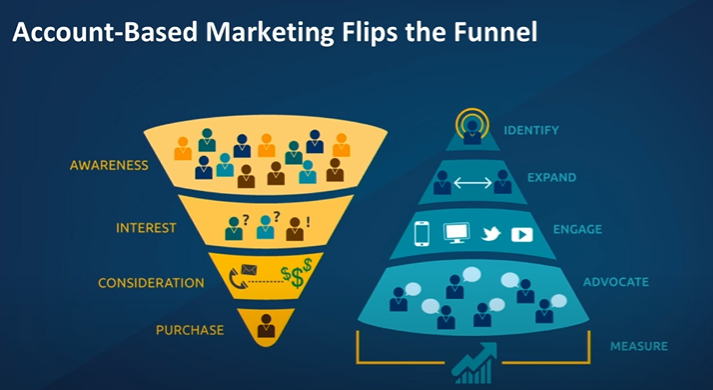
Account Based Marketing flips the funnel (Terminus)
B2B Buying Trends 2022
1. Buyer Self Education
Business Buyers are doing more of their own research and Self educating in the “dark” before reaching out to sales teams. They are defining their problems, selecting their buying criteria and organizing their buying committees without suppliers knowing.
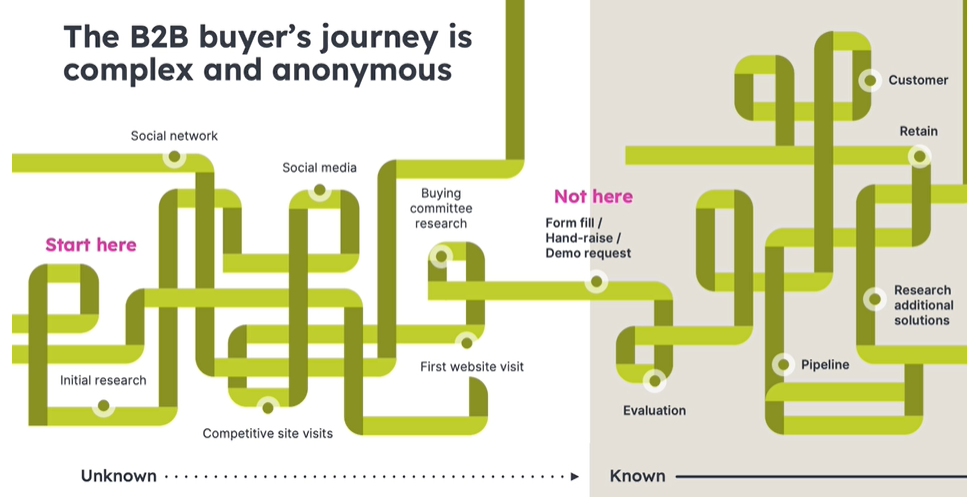
B2B buyer Journey (DemandBase)
2. Larger Buying Committee’s
According to a study by Bain Consultancy:
- Buying committees are growing, with five or more people making up 50% of purchases.
- For higher value purchases 75% of buying committees have five people or more, while 50% have eight people or more.
Buying Committees involve cross functional teams across; IT, Finance, Product, Procurement, Engineering, Sales and Marketing. To get “Buy In” from each member of the buying committee you will need to find out what is uniquely important to each one of them. For example, somebody in Product will care about the product features, while someone in Finance will want to know about the ROI (Return On Investment), Payback Period and how it will influence KPI’s.
Software Engineers will care deeply about the developer environment and how easy it is to use the API (Application programming interface). While the IT department will care about how the technology will integrate into their existing tech stack and make their lives easier.
Pro Tip. The key is to find out which metrics are important to each member of the buying committee and target personalized content accordingly.
Note: Junior people are much also more involved in buying decisions and educated, thus they shouldn’t be overlooked in the targeting.
3. Personal Touch Still Matters
The good news for businesses is Customers are willing to spend more online with 15% of B2B decision makers willing to spend over $1 million online. But according to McKinsey, B2B customers are still saying the “personal touch matters”, they see it as a sense of how much the supplier values them.
The Rule of thirds applies: 1/3 in person, 1/3 remote, 1/3 self service.
40% want in person (can be virtually) with rep for high value products over $1 million. 80% of B2B customers will actively look for another supplier if their service isn’t seamless. Thus showing genuine care for each account is more vital than ever.
Benefits of Account Based Marketing
According to the Gartner Benchmarks Survey, those businesses which implemented an ABM strategy saw many benefits across both Marketing and Sales these include,
Marketing Benefits:
- Improved conversion rate (through the entire funnel)
- Increased Web Traffic
- Improved Advertising Performance
- Improved Email Metrics (open rates etc)
Sales Benefits:
- Faster Sales Cycles (Sales)
- Higher Win Rates (Sales)
- Increased Deal Size (Sales)
Account Based Marketing| 4 Step Strategy |
To implement an Account Based Marketing Strategy there are various frameworks we can use, but all get to a similar outcome.
- A simple framework is called T.E.A.M. which stands for; Target, Engage, Activate, and Measure. (Terminus)
- Adobe Marketo uses the three step process: Identification, Marketing, Measurement.
- At Social Genie Digital, we draw elements from various Frameworks but will outline our four step model Define, Map, Engage, Measure.
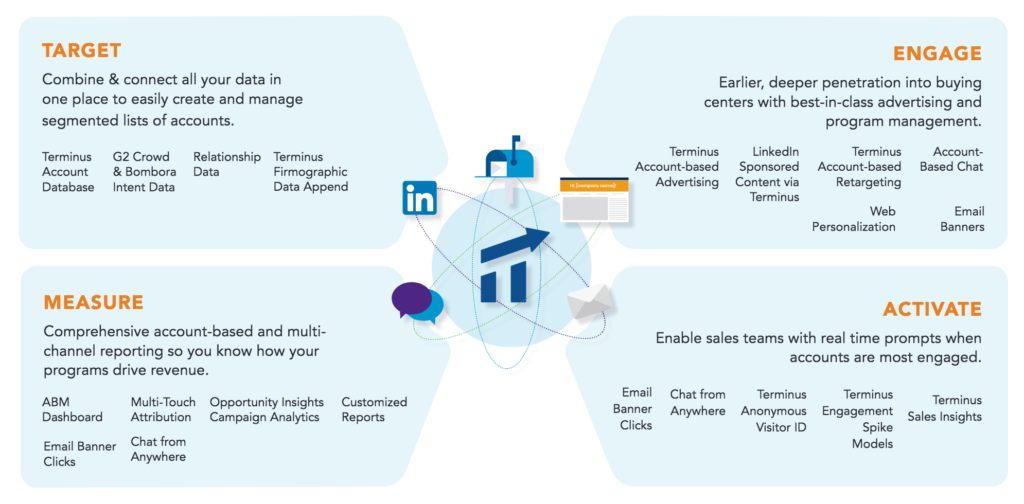
Account Based Marketing (Terminus).
Step 0. Align Sales and Marketing | Pre Requisite
Traditional Marketing involves lead generation of “Marketing Qualified Leads (MQL’s)” which are passed over to Sales at the latter part of the funnel. However, Successful Account Based Marketing strategies require “lockstep” alignment between Sales and Marketing Teams. According to a study by Bain, “Winning Organizations” maintain higher levels of cross functional collaboration. With 22% of Sales Teams having a Marketing Representative joining weekly pipeline reviews. This close alignment helps to build trust between teams and also allow both sides to gain greater insight into customer pain points. In addition, Marketing can provide Sales with “Sales Enablement” tools as they would with a traditional product marketing strategy. Account Based Marketing is sometimes called “Account Based Experiences” and is really a whole organization priority.

ABM Marketing and Sales Alignment. Source; Bain Study

Account based marketing. Bain
Step 1. Define Ideal Customer Accounts
Similar to Defining an Ideal Customer Persona, an Ideal Customer Account or Profile (ICP) is a Target company which is most likely to buy your product or service. This can be found by looking at the most high value customers the business already has and which other accounts fit a similar criteria. Ideally Marketing and Sales should work closely together to select target accounts which are most valuable.
Selection Criteria generally can be split into four main categories:
- Demographics: Industry, HQ location, number of employees.
- Psychographics: Motivations, values, purchase decision patterns
- Technographics: Technologies and resources utilized by the organization
- Life cycle: Development stage, Digital Transformation process.
To gather this data various independent sources can be used: Your Customer Database CRM (Salesforce/Hubspot), Crunchbase, LinkedIn, Zoominfo, Craft, Email Hunter etc. At Social Genie, we like to use an all in one platform such as Demandbase for our larger clients.
Pro Tip. Be Curious about your Customers.
Conduct Customer Surveys, Partnerships and even Focus Groups. This helps to deeply understand your existing customers better, how they found your service, how they use your product, their incentives and what they truly value. You can then use this qualitative data and even the vocabulary used to inform marketing and sales messaging later.
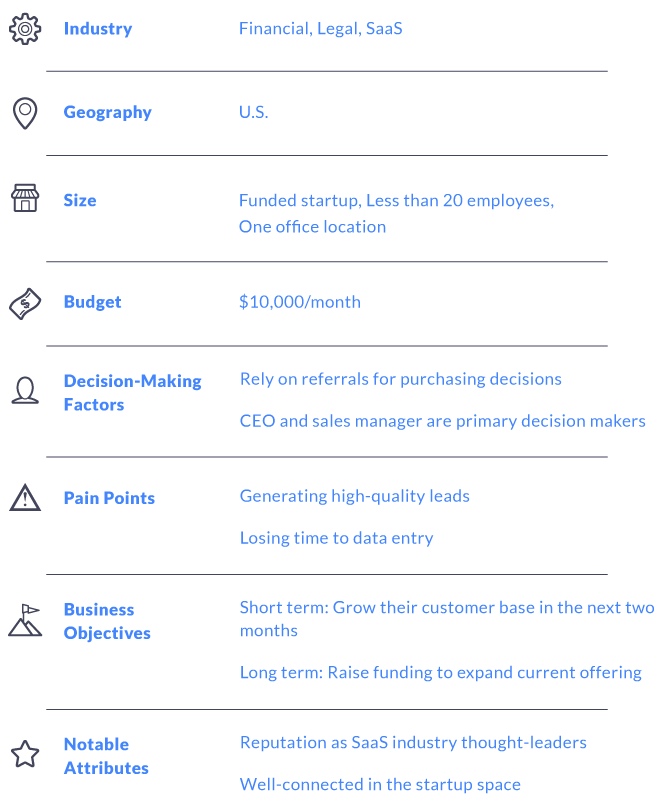
Ideal Customer Profile 3
Step 2. Map Target Accounts & Allocate Resources
How Many Accounts Should You Target?
The number of Accounts you should target depends upon the company size, resources, budget and industry. For example, with previous clients we targeted 30 accounts and had a top 5 “hit list” of the most valuable accounts, which would require the most personalized “One to one” approach. According to a study by Bain, 50% of “Winning Companies” target less than 100 accounts and have a more focused approach. The challenge is figuring out how your target accounts are structured, how decisions are made (buying criteria) and who the key decision makers, influencers and “gatekeepers”.
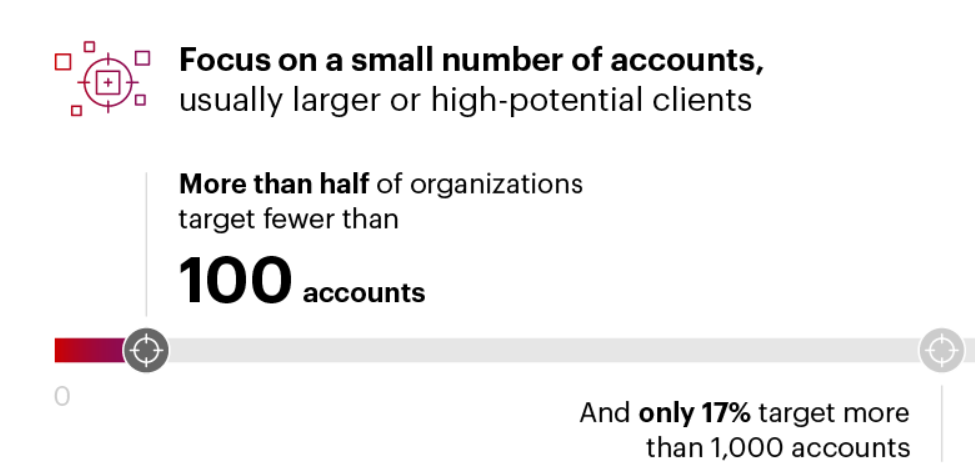
Account Based Marketing, Number of Target Accounts. Source: Bain.
How to Allocate Accounts?
There are three main ways of targeting accounts and this depends on resources, business size, software etc.
- One to one. A dedicated senior marketer works with a single highly valued and large account.
- One to few – A marketer will work with 3-10 accounts, usually grouped by the same industry, regions, company size, CEO priorities or where they are in their digital transformation journey.
- One-to-many. A marketer working with 8 to 15 accounts from the selected account list. This method will usually require the assistance of software such as Demandbase, automation and a team to generate personalized content.
Pro Tip. The bandwidth of each individual marketer can usually be the biggest challenge to high quality ABM. Thus we suggest limiting the amount of accounts for each individual marketer (without a team) to three. This will enable them to really gain deep insight into an individual company account.
This can also enable the “spearfishing” method which involves targeting ideal clients and marketing directly to key decision-makers.
According to the Founder of the Gold Standard Automation platform Marketo Engage:
“ABM, to me, is fishing with spears by putting more resources and more energy into going after the right people, the right accounts.”
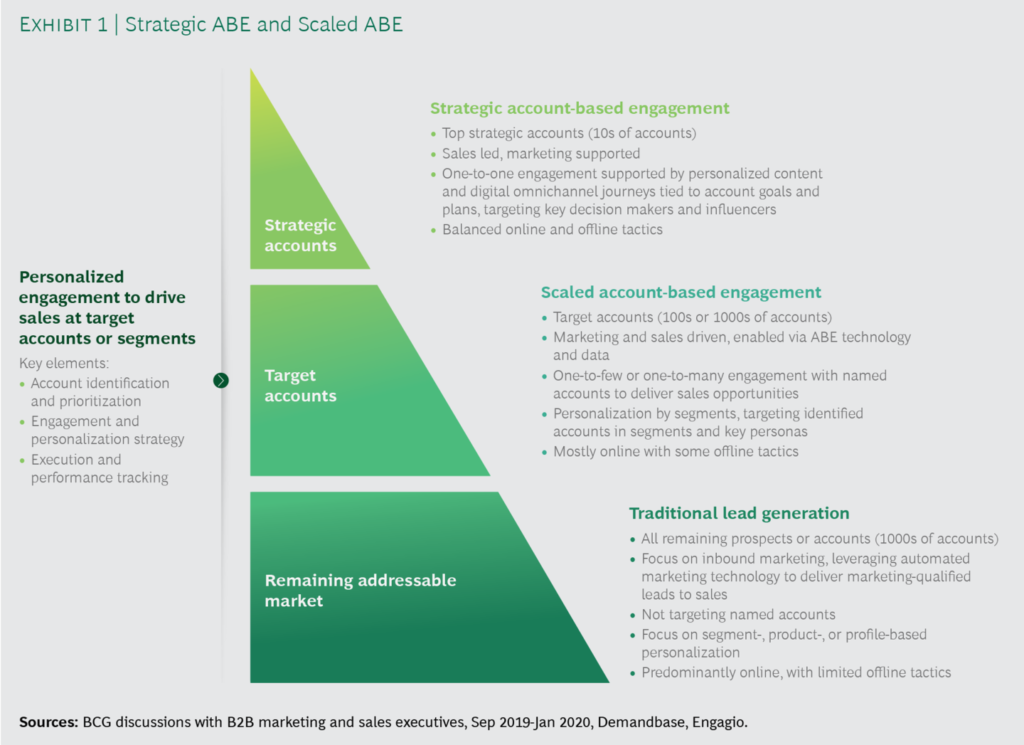
Account Based Marketing (Bain)
Step 3. Hyper-Personalized Marketing | Engage |
Once you have defined your target accounts and decided on the basic mapping strategy, then it’s time to start a “Nuture” campaign to “Engage” with these accounts.
Hyper-Personalized Content
The Goal is to provide VALUE during every interaction. Don’t “sell” but instead offer to help. This can be done through Hyper Personalized Content, which is functional specific and industry relevant
“The Right Message, to the Right Person at the Right Time”
“Be a REFLECTION of the person you want to market to”
Why Personalized Content?
- 73% of customers prefer personalized shopping experiences
- 86% say personalization is key to influencing their purchase decision. (conversionxl)
- Personalized Call to Action (CTA’s) result in higher conversion (Hubspot).
This is why at Social Genie we like to say “Personalisation = Profit”. Account Based Marketing is really an extreme form of “Personalized Marketing”, in other words “Show me that you know me”. According to a McKinsey study, Executives who invest deeply into understanding their customer via interviews, focus groups etc, tend to perform better. Communicating these insights across the entire organization also makes sense so everyone understands who their Ideal Customer Profile (ICP) is, the tone of messaging and content style.
Pro Tip. Through our client experience we have noticed QUALITY is valued much more than QUANTITY. Of course ideally it’s nice to have both but try to make the trade-off on the quality side. For example, each email should be deeply thought through, each tagline, each blog post or piece of content. For some businesses this may involve “giving away” what usually would be “gated” content in that a prospect would have to enter their email. The goal is to give the target account so much value that they have strong positive sentiment towards your brand.
Channels | Where is their Attention?
After defining your Target Accounts or “Ideal Customer Profile” the next step will be to ask,
Where is the attention of each member of the buying Committee?
As mentioned in the “B2B Trends” section, buying committees. 50% of buying Committees involve 5 or more people across multiple functions from the C-suite, to IT, Finance, Product, Procurement, Engineering, Sales and Marketing.
There are three channel types: Owned (own website), Paid (paid ad’s) and Borrowed (Organic social media).
- Social Media Platforms (Linkedin)
- Blogs/Websites (Paid Media & Content Syndication)
- Google Search Ad’s.
- Industry specific Youtube Channels.
- Industry Podcast’s.
- Industry Events and Tradeshows. Ex. (Money 20/20 for Finance)
- Virtual Events (with industry experts/Thought leaders as guests)
- Email Newsletters (Sponsored, Syndicated etc)
- Existing Partners, or Form new partners.
- Communities and private clubs.
- Host events for account members (Dinners, sporting matches, Events)
For example with regards to Blogs and Whitepaper’s, A Finance decision maker may read “CFO Daily News (Resourceful Financial Pro)” or the Financial Times. Whereas, an IT professional will read specific technology blogs and may be interested in Whitepapers.
Pro Tip. People are people. For example, with one of our clients we found out they were a massive Ed Sheeran fan and managed to secure tickets to a sold out concert for the prospect. This resulted in a warm feeling towards us as a brand and greater account expansion. Now although this is a “non traditional” approach it really is just about being “Curious about your customer” , identifying what is important to them and how you can make a difference.
Pro Tip: Becoming a Thought Leader in the specific industry, is a smart way of providing value to your ideal audience. Find out the “concerns” of each member of the buying committee and then create content to help them solve this.
Owned Channels:
- Your own Website/Blog
Pro Tip. Invite Customers to Contribute to your blog and Vice Versa.
- Segmented Email Campaigns (Automation).
- Phone Number Lists
- Existing Relationships to “open doors”.
Pro Tip. If developing a Go to Market strategy for a new market or industry vertical it makes sense to hire experienced Senior Leaders who are well connected in an industry and can “Open doors” for your business.
Step 4. Measure Results and Technology
No matter which campaign you do, be sure to measure results with data. This could be via Google Analytics, recording the number of Sales Meetings booked, tracking engagement via the number of website visits, content downloads “Content Bingeing”, Demo’s booked and more. As you wish to scale your efforts you will need the right technology stack. This involves a CRM (Customer Relationship Management) system such as Hubspot or Salesforce, Marketing Automation platform (Hubspot, Marketo etc) and of course a B2B software such as Hubspot ABM, Demandbase, Terminus or Linkedin Marketing Solutions. The challenge with account based marketing is identifying and tracking the accounts. Some technologies such as Demandbase allow IP address tracking of each member of a buying committee. A platform such as “DRIFT” uses “Conversational ABM” to engage target accounts with conversational chat bots when you visit a website. This platform also integrates with Demandbase.
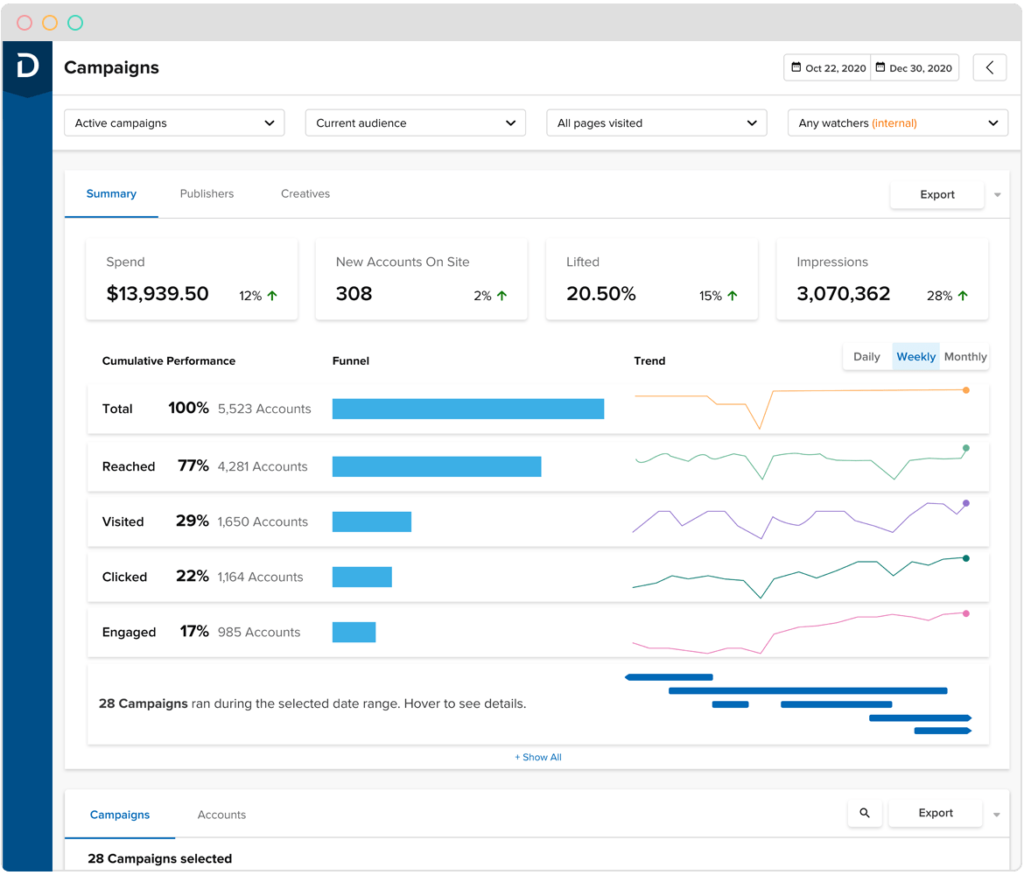
DemandBase platform screenshot
How to get started with ABM?
Depending on the company culture opinions vary on if Account Based Marketing should be used. For our clients we recommend running a “Pilot” or test program with a portion of resources being allocated to ABM. Then use leading indicators to track engagement and if it’s “working”, after which you can scale accordingly. Some of our clients also opt for a “double funnel approach” in which they keep their traditional lead generation tactics and also use ABM. But generally if your business is selling a complex, high ticket product where only a few buyers qualify, then it is likely best to lean more towards ABM.
Do you need help with your Marketing?
If you need help setting up a Digital Marketing Strategy for your Business, Account based or other then feel free to reach out to us on the email: Socialgenie@europe.com or via the contact form here.

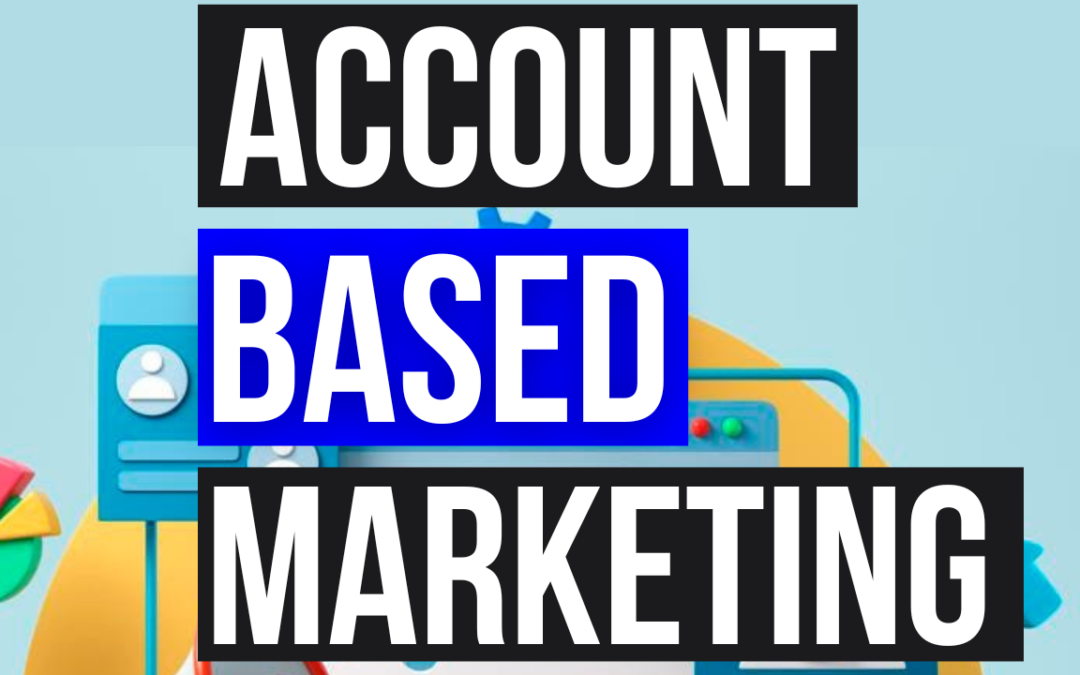
Recent Comments